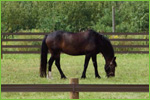Tendonitis
Tendonitis is inflammation of the tendon. It is commonly seen in the superficial and deep flexor tendons, particularly in the forelimbs. Superficial digital flexor tendon injuries are the most common cause of lameness in thoroughbred racehorses and a significant economic problem within racing. They cause many horses to be retired. Deep digital flexor tendonitis is a more serious cause of lameness in event and hunting horses.
Tendonitis is a type of repetitive strain injury, which usually occurs in pairs of limbs.
Acute tendonitis is usually seen within a few hours of racing or other exercise. A horse suffering with tendonitis would present with very painful swelling of the tendon and the surrounding area.
Sometimes damage to the tendon can be much more subtle. There may be no visual change to the outside of the limb and only a very mild/intermittent lameness. Tendon pathology is then diagnosed via lameness workup and usually an ultrasound scan.
Tendonitis is prone to reoccurrence. When the tendonitis heals, scar tissue will replace the damaged tendon. The scar tissue is weaker and less elastic than the original tendon and is prone to further tendonitis. Tendonitis typically occurs at the junction of the scar tissue with the healthy tendon.
Treatment of Tendonitis
A splint with a heel wedge is often applied to prevent further damage before assessment by ultrasound.
NSAIDs are used to control the pain and inflammation of tendonitis. Various other treatments, including stem cell technology, are evolving to minimise the amount of scarring and maximise the formation of healthy tendon tissue.
Tendon injuries are the most common cause of lameness in thoroughbred racehorses and a significant economic problem. They cause many horses to be retired.


